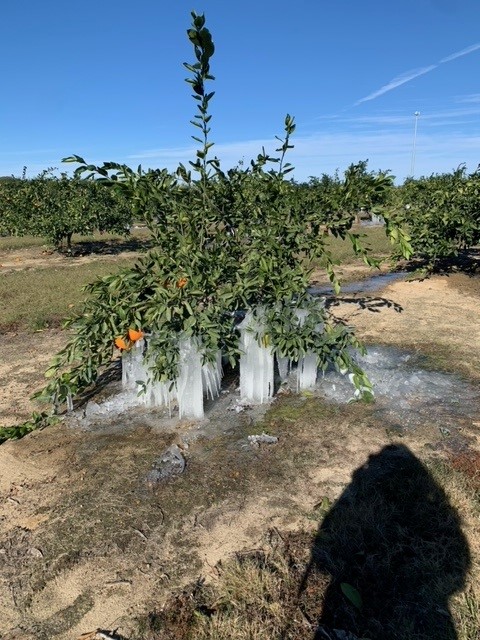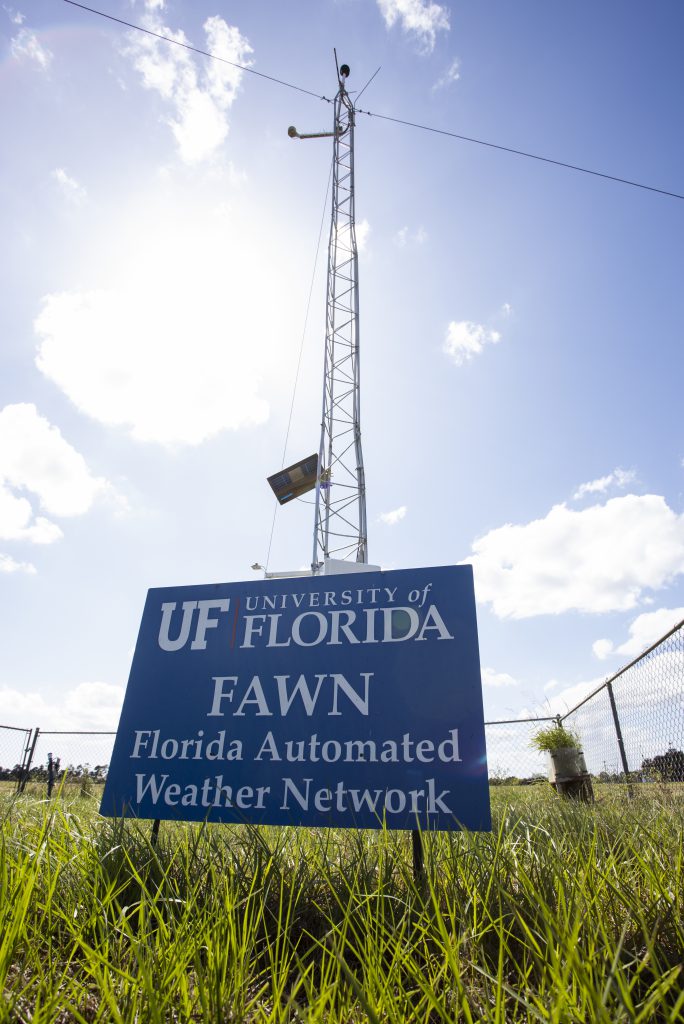Because of the extended hard freeze event in December of 2022, citrus farmers in the Panhandle will have a greatly reduced citrus harvest this year. It is very hard to prepare in advance for stressful weather like freezing temperatures, but if you equip yourself with the tools available, you should be able to reduce the damage.
Historically, Florida’s temperatures are very moderate during the winter months, but as we all know, weather is very unpredictable year to year. Because the weather conditions are so favorable here during the cool season, higher production in citrus, vegetables, and ornamental plants is possible with reduced risk compared to other states. Even though our weather stays relatively mild, it does not mean the temperatures cannot drop to below freezing. According to the National Weather Service, 56 hours out of the 72 hours of the 2022 Christmas freeze event were recorded as below freezing temperatures in the Florida Panhandle.
There are several methods of freeze protection utilized in the citrus industry in Florida. Many growers are leaning toward the use of “heat blankets.” Heat blankets are used to capture heat that is created from the soil temperatures during the daytime and to prevent it from quickly radiating it back into the atmosphere during the night. But the most common form of cold protection in Florida is the use of water. Growers that use water for freeze protection services must determine the minimum critical temperature of their citrus trees and then be equipped to operate their irrigation systems to prevent damage to the crop.
Cold protection utilizing irrigation systems was initially taught to growers by knowing the correct time to turn their systems on and off. The Wet-Bulb Based Irrigation Shutoff Temperature tool was created to tell growers the safest time to shut off their irrigation systems based on their critical temperature to avoid tree damage due to evaporative cooling (Jackson, et al., 2023).
–
FAWN Cold Protection Toolkit
UF/IFAS Extension’s Florida Automated Weather Network (FAWN) has assembled what is called a “Cold Protection Toolkit.” There are currently 6 resources/tools that can be used in preparing for a freeze event. They allow growers to set their critical temperature for their crop (or trees in this scenario) to be used with the other resources in the toolkit. Growers who are unsure of their crop’s critical temperature can find more information through the FAWN website: Determining Critical Freezing Temperatures for Plants in Florida.
As mentioned before, there are 6 resources available in the Cold Protection Toolkit. One being a “FAWN Freeze Alert Tool” that allows growers to receive a text and/or email message when certain conditions occur at the FAWN station closest to them. There is also an NWS Graphical Forecast tool that provides a graphical forecast for temperatures, wind, and rainfall. There is an estimation tool for minimum overnight temperatures based on the Brunt equation and a forecast tracker that plots the actual and forecasted temperatures to show how well the forecast is tracking the actual temperature.
The “Evaporative Cooling Potential” feature utilizes the Jackson/Cross/Fayrna Evaporative Cooling Table. This table shows 4 categories of risk and criteria for each category. The way the format is currently setup, the user-supplied forecasted values of air temperature, wet bulb temperature, and wind speed are used along with the table to determine if evaporative cooling is possible. If a grower chooses to use irrigation systems, which more than likely they will, there will always be some undertaking of risk in terms of freeze protection. Wet bulb temperatures of 6 degrees Fahrenheit or lower than the air temperature can result from windy and dry conditions. If evaporation occurs from windy and dry conditions blowing over a wet plant surface, this can cause the plant’s surface temperatures to be lower than the actual air temperature. This is what we call evaporative cooling, which can result in plant damage when the wet bulb temperatures lower past the critical temperature of the plant or citrus tree. If you are using irrigation on nights that the air temperature could potentially be close to the critical temperature, this could cause more damage than if no action was taken at all. By utilizing the Evaporation Cooling Prevention feature along with leaf freezing temperature data, citrus growers could potentially save money and water, while also reducing the risk of evaporative cooling damage to their citrus trees.
The Wet-Bulb Based Irrigation Cutoff Temperature tool is also a key tool for growers in the toolkit. This feature uses the current air temperature and the wet bulb temperature (both temperatures are calculated at the FAWN site), takes the difference, and calculates a “new” wet-bulb temperature at the critical temperature (Jackson, et al., 2023). The new wet bulb temperature is the temperature that the grower can safely shut the irrigation system down. This tool is supposed to simplify basic freeze protection off the recommendation to “discontinue irrigation when the wet bulb temperature reaches the critical temperature of the crop being protected.” (Harrison, et al., 1974).
According to John Jackson and colleagues, the FAWN Cold Protection feature will provide growers with a guide for when to start and stop their irrigation systems for each freeze/cold event, which can have a great impact on water conservation and money. Use of the FAWN Cold Protection Toolkit can “save an estimated 2 hours of irrigation per cold event” (Jackson, et al., 2023). Start familiarizing yourself now with these tools so you are well prepared for the next major freeze.
–
For more information please visit:
Citrus Cold Weather Protection and Irrigation Scheduling Tools Using Florida Automated Weather Network (FAWN) Data
Cold Protection Toolkit
Florida Automated Weather Network
- 2026 Tri-State Fruit & Vegetable Conference – January 29 - November 7, 2025
- Direct Marketing: How Panhandle Produce Growers Are Adapting - October 10, 2025
- Nutrient Management for Vegetable Growers in the Florida Panhandle - April 4, 2025


